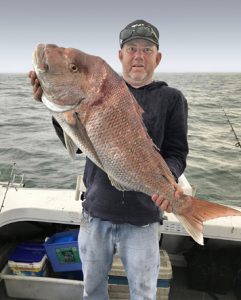
Col Erard with the 9.5 kg snapper that he caught in the rain off Leopold on Saturday morning (Picture: Malcolm Erard).
Corio Bay/Bellarine Peninsula
Making an early start from the St Helens boat ramp on Saturday morning, Col Erard and his brother, Malcolm, headed out past Point Henry and anchored up in 6 metres of water off Leopold.
Despite the heavy rain that hit at around 8.30, they battened down the hatches so to speak, and sat it out: A good move as it turned out, for Col’s rod bucked over; the scream of his reel heralding a 10 minute battle that eventually revealed the shape of a big snapper in the heavily discoloured water below.
That fish greeted the scales for a verdict of 9.5 kg, but it was by no means all they caught, with four good size pinkies to follow, along with six really nice flathead, the biggest measuring 50 cm.
Fishing from the breakwater at St Helens on Saturday were Seiya Koyama, his son Gaiji and Seiya’s father in law, Noboru Takefuji; all hoping for some Australian sashimi. Not in vain as it turned out – judging by the photos they sent in – of not only their catch, but a plate of mouth-watering sashimi flathead as well.
With the water heavily discoloured off the southern shore of Corio Bay’s outer harbour, it was no surprise when Andrew Johnson, who was fishing with Dennis O’Brien off Curlewis on Friday, hooked an obviously big snapper on his whiting tackle that unfortunately escaped after a lively tussle.
Fishing on Sunday in much the same area, this time with Dave Walder, Andrew found the wind against tide an almost insurmountable challenge. Never the less, they also finished with their respective bag limit catches of whiting, so good was the bite.
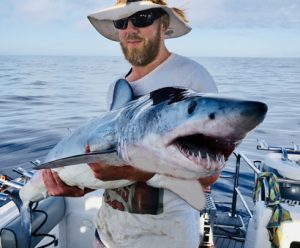
Paul Carson with one of the mako shark he and his crew took during the early hours of Saturday morning off Portland (Photo Kevin McLoughlin).
Barwon estuary
Fishing the Barwon estuary last week, some distance upstream from the Sheepwash, Keith Berry and Tom Robinson were hoping to catch salmon or mullet to use as live bait for mulloway, but it was the last of the outgoing tide and pickings were lean.
The afternoons’ incoming tide saw an improvement though, with both anglers fishing with live mullet on their heavier tackle. However, it was no mullet that was taken, but a pipi on Keith’s small, bait-catching outfit that initiated an extended battle that eventually saw an 85 cm mulloway in the landing net.
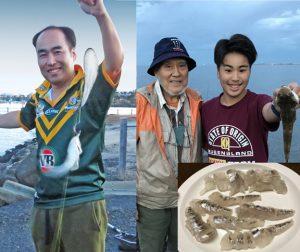
Seiya Koyama, his father in law Noboru Takefuji – who is visiting from Japan – and son Gaiji with their catch from St Helens, and subsequent plate of flathead sashimi.
Portland
Around midnight on Friday, Kevin McLoughlin, Brian Nolan, Paul Carson and Frank Farrugia headed offshore in search of mako shark.
During the early hours of the morning, they caught four as it turned out, the biggest around the 80 kg mark, of which they released three and kept one of about 40 kg. Although they stayed until after sunrise, the bite had finished by then.
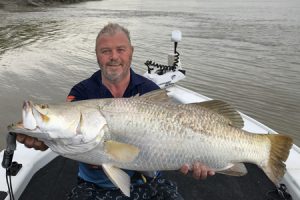
John Clements of the Lake Purrumbete Holiday Park with the 99 cm Barramundi he caught from the South Alligator River during last week’s Kakadu Clash.
Kakadu Klash
John Clements, manager of Lake Purrumbete Holiday Park, along with Chris Farrugia and Bruno Portaro, made up Victoria’s team No 11 (Nitro), that fished the Kakadu Klash; a barramundi – catch and release – competition, held on the South Alligator River in Northern Territory’s Kakadu National Park last week.
They won the competition outright with their largest three barra measuring 99, 89, and 108 cm, accruing a tally of 296 points. Second, was team 24 (Arnhem Land Coastal Camp) with 282 points, and the team from National Australian Fishing Magazine came third with 266 points.
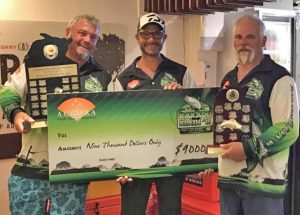
John Clements, Chris Farrugia and Bruno Portaro picking up their winner cheque at the Kakadu Klash.
Doug asks:
Geoff,
My brothers and I are going to Portland for the tuna and albies over Easter. We have a 6 metre boat and plenty of fuel, but I’m not sure where to look: Can you help?
Doug, my advice from Bob McPherson was that most recent catches of tuna have come from the shipping anchorage some 14 km east of Portland in 30-40 metres of water.
Historically though, at this time of year – and particularly with recent sightings of tuna by cray fishermen just west of the South Australia border – most tuna have been caught to the west off Capes Grant, Nelson and Bridgewater.
However, should you want to target albacore as well as tuna, you would need to fish much wider out, preferably on a bearing of 210 degrees south west from Lawrence Rock, where – depending on the weather – it may take you an hour or so to find productive water, which is often betrayed by circling birds and leaping fish.
